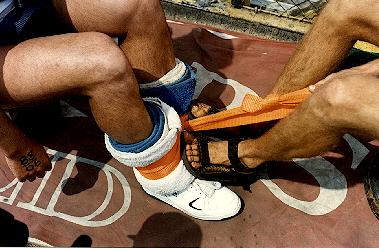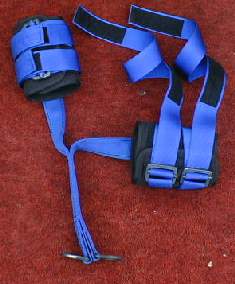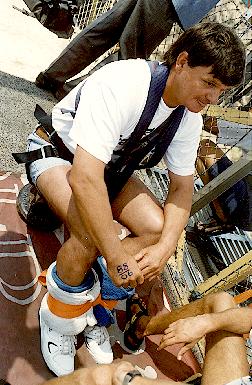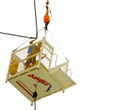Bungee Harnesses
Leg Harnesses
I have seen two types of leg harnesses used in Bungee. The first is very simple and is used by many clubs - most noticeable A.J. Hackett. The second type is a more traditional buckle harness. I feel much more secure in a buckle up harness, but have jumped in both. I have never heard of either leg harnesses failing.
A Towel and a bit of Webbing
 Image Courtesy of African Extreme |
This method of attaching the jumper to the rope was pioneered by AJ Hackett and is used by many companies. It's very simple and quite comfortable for the jumper. It also doesn't take a long time to tie. It's quite simple, a towel is wrapped around the jumper's legs (as padding) Then a webbing sling (closed loop) is tied over and around the towel to secure the jumper. As the webbing takes load, it only gets tighter. No real knots are involved as such. Despite it's simplicity - there is a special technique to trying this harness - NO NOT try this at home - you could kill yourself! |
Custom Made Harnesses
I recently contacted Petzl who were most helpful. They have on their computers a 'Harness for Bridge Jumping' (product code C84) and it retails at around 140 pounds (Sterling, approx. $200 USD). There was no picture in the catalogue so I can't be sure this is what you want. If they are anything like the one's I have used before they will have two webbing straps and be about shin height. They feel Very secure and have a log piece of webbing to attach to the cord. Each foot is separate and so walking in them is easy.
Other climbing equipment manufacturers may be able to help make harnesses for you (or may even make them already). The harnesses we used at NW Bungee were a lot slimmer and only had one webbing strap on each foot. They were stitched together at the ankles and so walking in them was very difficult, also there wasn't much webbing between the harness and the connection point.

Here is a typical custom manufatured ankle harness as used by Bungee Experience. Note the black padding that goes between you and the blue webbing straps, this makes for a very comfortable jump. The Blue webbing straps are firmly held with two big buckles per leg and then the extra webbing is wrapped around your leg one more time and secured with velcro. Each harness is functional in itself but they are stiched together just to prevent the cords getting between your legs and tangled.
It is possible to jump with your wrists strapped into these harnesses (although I wouldn't try it!)
Body Harnesses
All the clubs I have jumped with have used a 2nd harness as a backup. In Copenhagen this was just a Petzl Mercury sit harness (Product code C31). I was a bit dubious as to it's ability to hold me in when dangling upside down, but since it's what I climb in normally I had a lot of faith in it. At NW Bungee we used some Troll Climbing harnesses (very adjustable) and also a shoulder/chest harness to make sure jumpers had full backup. We sometimes jumped with just these on for a free legs experience. In France they used a full Petzl body harness 8003 (Product code C05), this was very adjustable and I found it very comfortable. Combined with the Petzl leg harnesses I felt very comfortable and secure.
Putting at all together
|
Many clubs use all of the above. a leg harness to take most of the weight, and a body harness, or a climbing harness (with option shoulder support) for backup and also to make the ride back up more comfortable - if they do haul you back up. On the right you can see a typical Bungee Harness. Note the webbing around his shoulders are part of the harness, which will be a backup and also make the ride back to the jump platform more comfortable (mostly because he'll be the right way up!) Also notice how he has his weight written on his hand - this is to help with double (and sometimes triple) checking everything. A practice which is helping to make Bungee Jumping safer and safer. Back to Cord |
 Image Courtesy of African Extreme |



